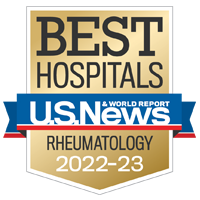
Gout
Gout is one of the most painful forms of arthritis and one of the few in which the cause is known. In many cases, inflammation initially develops in the joints of the big toe, a condition called podagra. It also can affect the instep, ankles, heels, knees, wrists, fingers and elbows.
Although there is no cure for gout, the majority of patients are able to manage their symptoms with medications. The disease typically affects men over the age of 30, post-menopausal women, African Americans, people with kidney disease and those who have had an organ transplant. In addition, some families are genetically predisposed to the condition. Gout is strongly associated with obesity, hypertension, hyperlipidemia and diabetes.
The condition results from deposits of needle-like crystals of uric acid in the connective tissue and joint spaces. Uric acid is a byproduct of the breakdown of waste products in the body. Normally, uric acid is eliminated through the urine. When the body increases its production of uric acid or if the kidneys do not eliminate enough of it from the body, levels build up and cause gout.
Our Approach to Gout
UCSF provides comprehensive evaluations and advanced care for all forms of arthritis, including gout. Our team includes doctors from several specialties, including rheumatology, orthopedic surgery, dermatology and plastic surgery. We offer specialized imaging studies and immunologic testing, as well as a range of standard and investigational treatments.
Gout is caused by a buildup of uric acid in the body. Most patients are able to ease symptoms and stop a gout attack with either nonsteroidal anti-inflammatory drugs or corticosteroids. Patients who suffer repeated gout attacks or advanced gout may need different medications to normalize their levels of uric acid.
Awards & recognition
-

Among the top hospitals in the nation
-

Best in California for rheumatology
UCSF Health medical specialists have reviewed this information. It is for educational purposes only and is not intended to replace the advice of your doctor or other health care provider. We encourage you to discuss any questions or concerns you may have with your provider.





